Garage & Batten Lighting Buying Guide
Garage & Batten Lighting Buying Guide
Introduction
Deciding what type of functional or commercial lighting to install can be difficult, as there are so many types available. The type you choose for task lighting in a domestic garage or workshop, for example, will be different from what you’ll need in public spaces, factories, or offices.
This guide will help you make the right choice. It covers everything you need to know about commercial lighting, from garage and emergency lighting to office and industrial space lighting. We look at the different types available, their features, and where they’re best suited. Plus we’ll highlight some key considerations to think about before you buy.
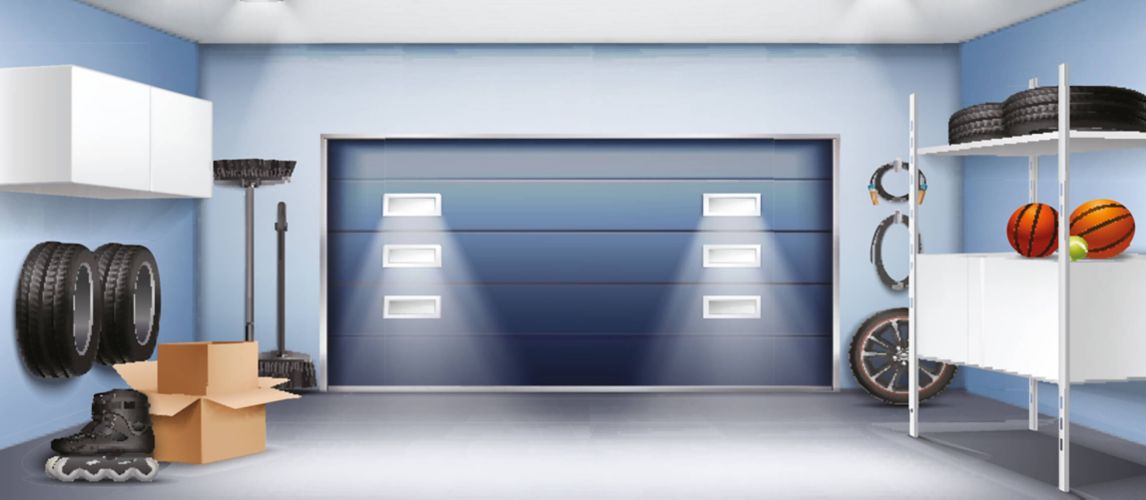
What Does Commercial Lighting Include?
Commercial lighting is the type of lighting typically installed in business premises, public spaces, and factories. But it can also be used in private garages and workshops where bright task lighting is needed.
There is a wide range available, each suited to different needs. Here, we look at the most common types of commercial lighting and where you might use them.
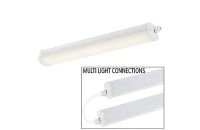
Garage and batten lights
LED batten lights are long, tubular strip lights commonly used in garages, workshops, car parks, and warehouses. Their design means light is dispersed evenly over larger areas.
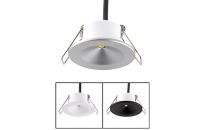
Emergency lighting
Emergency lighting comes in various shapes and sizes. But they are all designed to either remain on or come on in the event of a mains power failure. This means that walkways, stairwells, and service rooms can remain well-lit to enable evacuation or prevent accidents in an emergency situation such as a fire.
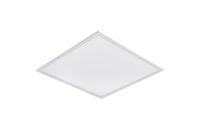
LED panel lights
LED panel lights are square lights designed to slot into the recess where a tile would sit within a grid ceiling. They distribute light evenly, offering wide and soft lighting that’s ideal for a range of commercial settings, such as an office or gym. In addition, LED technology means the lights are energy-efficient and environmentally friendly, and they have a lifespan of 25-30 years.
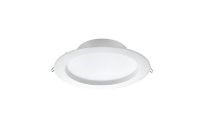
Commercial downlights
Commercial downlights are round spotlights that are recessed into the ceiling, usually in groups to cover large areas. They focus light downwards to give bright, high-intensity light to a room. Their simplicity makes them a popular choice for bars, hotels, and restaurants, but they can be used in other commercial settings too.
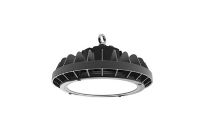
High bay lights
High bay lights are powerful circular lights hung from the ceiling on hooks, either directly attached to the ceiling or on long chains. They’re used in buildings with high ceilings, typically over 20ft, to illuminate large areas, such as warehouses, industrial facilities, factories, and gyms.
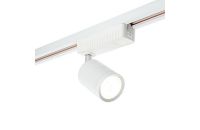
Other commercial lights
The commercial lights above are the most popular types, but there are some others, plus some accessories.
For example, track lighting is a practical solution for providing flexible lighting. A track is mounted on the ceiling or wall with a light fixed to it. The light can be pulled along the track to move it to a different part of the room. And the light has an adjustable rotating and tilting head to give maximum control.
Commercial bulk head lights are a type of emergency light that only uses 4 watts of power. They’re supplied with a rechargeable battery pack that provides three hours of emergency lighting if the mains power fails.
Commercial lighting accessories include panel mount light boxes and high bay reflectors. Panel mount light boxes are the fixtures used to house LED panel lights. And a high bay reflector is a light shade that sits over a high bay light to intensify the beam and create a higher intensity of light at floor level.
What are Garage and Batten Lights?
Batten lights are mains-powered strip lights. They are available in lengths between 2 and 6ft and come in single (one light tube) or twin (two light tubes) options. Multiple batten lights are usually used together to cover large areas.
Power consumption for batten lights varies considerably, ranging from 8 watts to 75 watts, depending on whether they use fluorescent or LED technology. Their life span also varies, as they can last between 10,000 and 50,000 hours of use, depending on which type you buy.
Batten lights are available in two colour temperatures; cool white, ideal for task lighting in a workspace, or daylight, perfect for bright lighting in a commercial or public space.
Batten Light Types
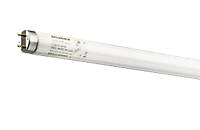
There are two types of batten lights which are differentiated by the technology they use to provide the light:
Fluorescent or neon battens
Fluorescent or neon battens consist of a fluorescent-coated glass tube filled with mercury vapour and gas. When electricity passes through the tube, invisible ultraviolet light is emitted, reacting with the fluorescent coating to produce visible white light.
Fluorescent battens are more energy-efficient than traditional incandescent lights (using 60-80% less energy), and they are cheaper to buy but only last 10,000 – 16,000 hours. They also don’t work well in low temperatures and are prone to flicker.
Due to the global shift towards more energy-efficient LED lights, fluorescent lights may become harder to find over the coming years. However, if a building has existing fluorescent lighting that stops working, the fluorescent starter within the tube can be replaced.
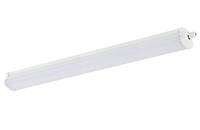
LED battens
LED battens are low-wattage lights that use light-emitting diodes to give off light. This technology emits light when electricity passes through it.
LED battens are a popular replacement for traditional fluorescent batten lights. They are incredibly energy-efficient (using up to 90% less energy than incandescent lights). This helps to lower energy bills and reduce a building’s carbon footprint. They are more expensive than fluorescent battens, but they last much longer (up to 50,000 hours). They also work well in low temperatures and are flicker-free.
Garage and Batten Light Features
Garage and batten lights can appear very similar to each other, but there are a few different features and options to consider before buying.
Batten light colour temperature
All lights produce slightly different colours (measured in Kelvin (K)), referred to as colour temperatures. The Kelvin scale ranges from warm, soft, yellowy hues (2700K) to cool, bright, crisp whites (approx. 6500K).
When it comes to batten lights, there are a few colour temperatures available:
- 4000K, which is described as cool white. This colour is ideal for a workshop or anywhere that needs task lighting.
- 6000k or 6500K, which is described as daylight. These energising colours are ideal for retail and commercial spaces such as shops and gyms.
Batten light output - lumens vs watts
When incandescent bulbs were still in use, the brightness of a light was measured in watts. So, a 100W bulb would be brighter than a 60W bulb. However, wattage is really a measure of a light’s power consumption, not brightness. Now that energy-saving lights use much less power to produce the same brightness as incandescent bulbs, brightness is measured in lumens (shown as lm). The higher the number of lumens, the brighter the light.
It's also worth considering a light's energy efficiency before you buy. Particularly if multiple lights will be switched on for prolonged periods. You can do this by looking at the light's energy label. But bear in mind that labels changed in March 2021. Old energy labels were rated from A++ to E. But, as most lights fell into the top rating, it was hard to differentiate between them. So, now the ratings go from A-G. Read our energy labels guide for more information.
- How many lumens do I need for garage lighting?
The number of lumens required for a garage will depend on its size and how it will be used.
As a guide, you'll need 50 lumens for every square foot of space for general lighting. So, a double garage will need twice the number of lumens of a single garage.
However, if there is a dedicated workspace in the garage, the light above it will need to be brighter. In that case, you'll need 300 lumens for every square foot. - How to calculate lumens for garage lighting
Measure the width and depth of the garage in feet, multiply the two sizes together to get the total square footage, then multiply that number by 50:
Width x depth = "total square footage x 50" = total number of lumens required
So, for example, for an average sized garage of 14ft wide and 22ft depth, the calculation will be 14 x 22 = 308sq.ft x 50 = 15,400 lumens.
To ensure good light coverage for the whole space, consider installing several lights that add up to the required number of lumens, rather than a single light in the centre. - How to calculate lumens for task garage lighting:
If a workbench is installed in a garage, brighter task lighting will need to be installed above it. To work out the lumens for this space, measure the width and depth of the workspace, multiply the two sizes together to get the total square footage, then multiply that number by 300:
Width x depth =" total square footage x 300" = total number of lumens required.
So, for a 14ft wide and 2ft depth workspace, the calculation will be:
14 x 2 = 28sq.ft x 300 = 8,400 lumens - How to calculate lumens for combined general and task garage lighting:
In this scenario, divide the garage into the two separate areas and do the calculations above for each area.
Colour rendering index (CRI) for batten lights
The colour rendering index is a scale of 0 to 100 that indicates the ability of artificial light to accurately display colours. A score of 100 means colour appears as it would in natural daylight. CRI scores of 90 or above are considered excellent, while scores of 80 or below are considered poor.
Batten lights with an excellent CRI score are essential in spaces where tasks involving colour are important.
What is Emergency Lighting?
Emergency lighting describes any type of lighting designed to either remain on or come on automatically in the event of a mains power failure. Emergency lights are provided in corridors and stairwells to illuminate escape routes and enable safe and fast evacuation. It can also be used to highlight the location of security equipment such as fire extinguishers.
When is emergency lighting required?
The Regulatory Reform (Fire Safety) Order 2005 makes it a legal requirement that any commercial premises or the common areas in a House in Multiple Occupation (HMO) must have emergency lighting installed. The lights must stay on for one hour following a power outage. And where there's sleeping accommodation, this increases to three hours.
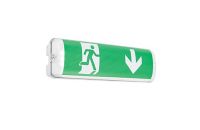
Types of emergency lighting
Several types of emergency lighting are available. The type needed will depend on where the lighting will be installed, its use, and whether it will be used solely for emergency lighting or not.
- Fire escape and exit lighting explained
Fire escape and exit lights are illuminated green signs that point in the direction of and highlight the location of fire exits. They guide people safely and quickly to the nearest fire exit if there is an evacuation. Because they are green, they are helpful even if normal lighting is still available. - What is a non-maintained emergency light?
Non-maintained emergency lighting is lighting that only comes on when there’s a mains power failure. The rest of the time, the light is off. The light links to the building's lighting circuit. It's triggered to automatically switch on when it detects a loss of power and will typically stay on for up to three hours. It's powered by a battery which charges itself through the mains power supply.
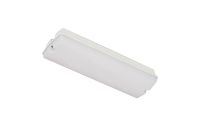
- What is a maintained emergency light fitting?
Maintained emergency lighting can be operated by a switch and used as soft, low permanent lighting powered by mains electricity. But it will also automatically switch to emergency lighting, using a battery power supply, if the mains power fails. This type of lighting is mainly used in places where groups of people meet, such as a cinema, to prevent total darkness.
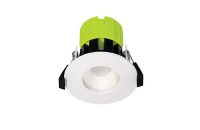
- What are fire-rated downlights
Fire-rated downlights are recessed ceiling lights that have the ability to slow the spread of a fire. Installation of downlights requires holes to be cut in the ceiling, which would mean a fire can spread quickly between rooms compared to a solid ceiling. A fire-rated downlight has an intumescent coating around its fitting that quickly expands and blocks the hole in the event of a fire, preventing it from spreading for 30-90 minutes.
Key Considerations When Buying Commercial Lighting
Here are a few more things to consider before purchasing commercial lighting:
-
How often should emergency lighting be tested?
A short functional test of emergency lighting should be carried out monthly to ensure it meets all safety requirements and reduces the risk of failing when needed most. In addition to this, a full test should be carried out annually. This involves the light being illuminated by its battery for the entire length of time it's required to work in the event of a power failure (i.e., one or three hours). To pass the test, the light must work and produce an acceptable level of light for the full duration. This test should be carried out when there's a low risk of an emergency to ensure the light has enough time to recharge the battery afterward. -
When are fire-rated downlights required?
In line with Part P Building Regulations, all downlights recessed into a ceiling must be fire-rated. This is because they help slow the spread of fire for between 30-90 minutes (depending on the light's fire rating), which would otherwise spread quickly through the holes cut into the ceiling. -
How many LED high bay lights do I need?
The number of LED high bay lights you need will depend on the size of the space, how high the lights will be hung, and the level of brightness required. As a guide, for normal brightness, space lights 25ft apart if they are being installed over 30ft high, 18ft apart for 20-30ft high installations and 14ft apart for 15-20ft high installations. -
What about IP ratings?
IP (ingress protection) ratings refer to how well lights are protected from dust particles and water. This is important to consider if the lights will be used in areas where dust is created, such as in a garage or workshop. Or in wet areas, such as bathrooms and kitchens, and in unheated garages and outbuildings. The rating is shown using the letters IP, followed by two numbers. The first number refers to how resistant the casing is to dust (ranging from 0-6). The second number refers to how water resistant the casing is (ranging from 0-8). The higher the rating, the more protected the light is.
